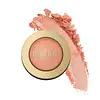What's inside
What's inside
 Key Ingredients
Key Ingredients

 Benefits
Benefits

No benefits
 Concerns
Concerns

 Ingredients Side-by-side
Ingredients Side-by-side

C12-15 Alkyl Benzoate
AntimicrobialIsononyl Isononanoate
EmollientPhenyl Trimethicone
Skin ConditioningMicrocrystalline Wax
Emulsion StabilisingPolyethylene
AbrasiveCaprylic/Capric Triglyceride
MaskingSynthetic Fluorphlogopite
Trimethylsiloxysilicate
EmollientSilica
AbrasivePentaerythrityl Adipate/Caprate/Caprylate/Heptanoate
EmollientPropylene Glycol Dicaprylate/Dicaprate
EmollientSorbitan Isostearate
EmulsifyingCaprylyl Glycol
EmollientTocopheryl Acetate
AntioxidantEthylhexylglycerin
Skin ConditioningStearalkonium Hectorite
Gel FormingAluminum Hydroxide
EmollientTriethoxycaprylylsilane
Tin Oxide
AbrasivePropylene Carbonate
SolventCI 77891
Cosmetic ColorantCI 77491
Cosmetic ColorantCI 19140
Cosmetic ColorantCI 15850
Cosmetic ColorantC12-15 Alkyl Benzoate, Isononyl Isononanoate, Phenyl Trimethicone, Microcrystalline Wax, Polyethylene, Caprylic/Capric Triglyceride, Synthetic Fluorphlogopite, Trimethylsiloxysilicate, Silica, Pentaerythrityl Adipate/Caprate/Caprylate/Heptanoate, Propylene Glycol Dicaprylate/Dicaprate, Sorbitan Isostearate, Caprylyl Glycol, Tocopheryl Acetate, Ethylhexylglycerin, Stearalkonium Hectorite, Aluminum Hydroxide, Triethoxycaprylylsilane, Tin Oxide, Propylene Carbonate, CI 77891, CI 77491, CI 19140, CI 15850
Talc
AbrasiveMica
Cosmetic ColorantGlyceryl Ethylhexanoate/Stearate/Adipate
EmollientDimethicone
EmollientOctyldodecyl Stearoyl Stearate
EmollientIsopropyl Myristate
EmollientPolyacrylamide
C13-14 Isoparaffin
EmollientLaureth-7
EmulsifyingSorbitan Stearate
EmulsifyingZea Mays Starch
AbsorbentLauroyl Lysine
Skin ConditioningMagnesium Aluminum Silicate
AbsorbentCetearyl Ethylhexanoate
EmollientSodium Dehydroacetate
PreservativeNylon-12
Imidazolidinyl Urea
PreservativeMethylparaben
PreservativeSilica
AbrasiveEthylparaben
PreservativePropylparaben
PreservativeButylparaben
MaskingCI 77891
Cosmetic ColorantCI 77491
Cosmetic ColorantIron Oxides
CI 19140
Cosmetic ColorantCI 15850
Cosmetic ColorantCI 15985
Cosmetic ColorantCI 75470
Cosmetic ColorantCI 77007
Cosmetic ColorantTalc, Mica, Glyceryl Ethylhexanoate/Stearate/Adipate, Dimethicone, Octyldodecyl Stearoyl Stearate, Isopropyl Myristate, Polyacrylamide, C13-14 Isoparaffin, Laureth-7, Sorbitan Stearate, Zea Mays Starch, Lauroyl Lysine, Magnesium Aluminum Silicate, Cetearyl Ethylhexanoate, Sodium Dehydroacetate, Nylon-12, Imidazolidinyl Urea, Methylparaben, Silica, Ethylparaben, Propylparaben, Butylparaben, CI 77891, CI 77491, Iron Oxides, CI 19140, CI 15850, CI 15985, CI 75470, CI 77007
Ingredients Explained
These ingredients are found in both products.
Ingredients higher up in an ingredient list are typically present in a larger amount.
Ci 15850 is the pigment color red. It is an azo dye and created synthetically.
Azo dyes need to be thoroughly purified before use. This allows them to be more stable and longer-lasting.
This ingredient is common in foundations, lipsticks, and blushes. This color is described as brown/orangey red.
It has many secondary names such as Red 6 and Red 7. According to a manufacturer, Red 6 usually contains aluminum.
Learn more about CI 15850CI 19140 is also known as Tartrazine. Tartrazine is a synthetic dye used in cosmetics, foods, and medicine to add a yellow color.
Tartrazine is created from petroleum and is water-soluble.
Some people may experience allergies from this dye, especially asthmatics and those with an aspirin intolerance.
Learn more about CI 19140Ci 77491 is also hydrated iron III oxide. It's sole purpose is to give a red/pink hue to products.
Iron III oxides are classified as inorganic chemicals for coloring.
Synthetically created Ci 77491 is considered safer than those naturally found. This is because the synthetically created version may contain less impurities. Iron oxides are generally non-toxic and non-allergenic.
Learn more about CI 77491Ci 77891 is a white pigment from Titanium dioxide. It is naturally found in minerals such as rutile and ilmenite.
It's main function is to add a white color to cosmetics. It can also be mixed with other colors to create different shades.
Ci 77891 is commonly found in sunscreens due to its ability to block UV rays.
Learn more about CI 77891Silica, also known as silicon dioxide, is a naturally occurring mineral. It is used as a fine, spherical, and porous powder in cosmetics.
Though it has exfoliant properties, the function of silica varies depending on the product.
The unique structure of silica enhances the spreadability and adds smoothness, making it a great texture enhancer.
It is also used as an active carrier, emulsifier, and mattifier due to its ability to absorb excess oil.
In some products, tiny microneedles called spicules are made from silica or hydrolyzed sponge. When you rub them in, they lightly polish away dead skin layers and enhance the penetration of active ingredients.
Learn more about Silica